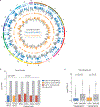Distinct nuclear compartment-associated genome architecture in the developing mammalian brain
- PMID: 34239128
- PMCID: PMC8410652
- DOI: 10.1038/s41593-021-00879-5
Distinct nuclear compartment-associated genome architecture in the developing mammalian brain
Abstract
Nuclear compartments are thought to play a role in three-dimensional genome organization and gene expression. In mammalian brain, the architecture and dynamics of nuclear compartment-associated genome organization is not known. In this study, we developed Genome Organization using CUT and RUN Technology (GO-CaRT) to map genomic interactions with two nuclear compartments-the nuclear lamina and nuclear speckles-from different regions of the developing mouse, macaque and human brain. Lamina-associated domain (LAD) architecture in cells in vivo is distinct from that of cultured cells, including major differences in LADs previously considered to be cell type invariant. In the mouse and human forebrain, dorsal and ventral neural precursor cells have differences in LAD architecture that correspond to their regional identity. LADs in the human and mouse cortex contain transcriptionally highly active sub-domains characterized by broad depletion of histone-3-lysine-9 dimethylation. Evolutionarily conserved LADs in human, macaque and mouse brain are enriched for transcriptionally active neural genes associated with synapse function. By integrating GO-CaRT maps with genome-wide association study data, we found speckle-associated domains to be enriched for schizophrenia risk loci, indicating a physical relationship between these disease-associated genetic variants and a specific nuclear structure. Our work provides a framework for understanding the relationship between distinct nuclear compartments and genome function in brain development and disease.
© 2021. This is a U.S. government work and not under copyright protection in the U.S.; foreign copyright protection may apply.
Conflict of interest statement
Competing Interests
The authors declare no competing interests
Figures














Similar articles
-
Role of lamins in 3D genome organization and global gene expression.Nucleus. 2019 Dec;10(1):33-41. doi: 10.1080/19491034.2019.1578601. Nucleus. 2019. PMID: 30755082 Free PMC article. Review.
-
Lamins Organize the Global Three-Dimensional Genome from the Nuclear Periphery.Mol Cell. 2018 Sep 6;71(5):802-815.e7. doi: 10.1016/j.molcel.2018.05.017. Epub 2018 Jun 28. Mol Cell. 2018. PMID: 30201095 Free PMC article.
-
Lamin C is required to establish genome organization after mitosis.Genome Biol. 2021 Nov 15;22(1):305. doi: 10.1186/s13059-021-02516-7. Genome Biol. 2021. PMID: 34775987 Free PMC article.
-
Chromosome territories, interchromatin domain compartment, and nuclear matrix: an integrated view of the functional nuclear architecture.Crit Rev Eukaryot Gene Expr. 2000;10(2):179-212. Crit Rev Eukaryot Gene Expr. 2000. PMID: 11186332 Review.
-
Major nuclear locales define nuclear genome organization and function beyond A and B compartments.Elife. 2025 Apr 25;13:RP99116. doi: 10.7554/eLife.99116. Elife. 2025. PMID: 40279158 Free PMC article.
Cited by
-
Extensive long-range polycomb interactions and weak compartmentalization are hallmarks of human neuronal 3D genome.Nucleic Acids Res. 2024 Jun 24;52(11):6234-6252. doi: 10.1093/nar/gkae271. Nucleic Acids Res. 2024. PMID: 38647066 Free PMC article.
-
Unfolding neural diversity: how dynamic three-dimensional genome architecture regulates brain function and disease.Mol Psychiatry. 2025 Aug;30(8):3781-3791. doi: 10.1038/s41380-025-03056-3. Epub 2025 May 23. Mol Psychiatry. 2025. PMID: 40410418 Free PMC article. Review.
-
Spatial 3D genome organization controls the activity of bivalent chromatin during human neurogenesis.bioRxiv [Preprint]. 2024 Aug 1:2024.08.01.606248. doi: 10.1101/2024.08.01.606248. bioRxiv. 2024. PMID: 39131314 Free PMC article. Preprint.
-
Chromatin protein complexes involved in gene repression in lamina-associated domains.EMBO J. 2024 Nov;43(21):5260-5287. doi: 10.1038/s44318-024-00214-1. Epub 2024 Sep 25. EMBO J. 2024. PMID: 39322756 Free PMC article.
-
3D Genome Plasticity in Normal and Diseased Neurodevelopment.Genes (Basel). 2022 Nov 1;13(11):1999. doi: 10.3390/genes13111999. Genes (Basel). 2022. PMID: 36360237 Free PMC article. Review.
References
Publication types
MeSH terms
Grants and funding
LinkOut - more resources
Full Text Sources
Other Literature Sources
Molecular Biology Databases

